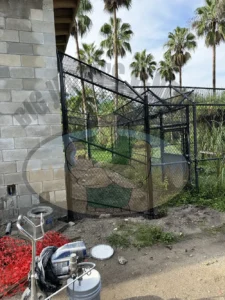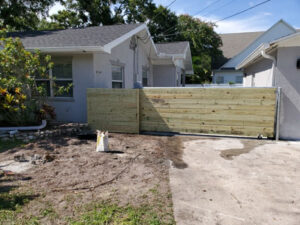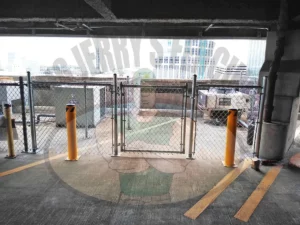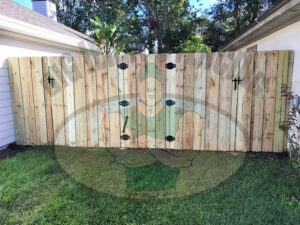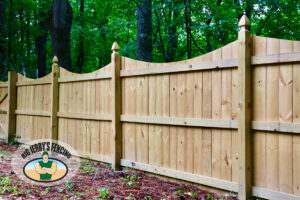Fences are a great investment if you install them smartly. They provide you and your neighbors the privacy everyone needs and prevent pets and children from going out of your yard. Fences can even add value to your home, so much so that according to a recent survey, a well-maintained fence will bump up your home’s value by as much as 20%, which is a big deal. Also, good fences make good neighbors. However, building a fence or connecting to a neighbor’s fence without consulting them could cause major issues. Fence disputes can turn the friendliest neighbors against each other.
TALK TO YOUR NEIGHBORS
In most cases, you’re not required to get any permission from your neighbor to build a fence on your own property. Keep in mind, though, that doing so can save you from disputes during construction, which can cost you time and money.
Additionally, if your neighbors don’t already have a fence installed, you can ask them to split the cost with you. You never know, right? It could be that your neighbor is planning on having a fence installed themselves. If your neighbor would benefit from a boundary fence on their property, they might happily agree to share the expense.
A lot of the traditional styles of fencing have a “good side” and an unfinished or backside. The good side shows the smoother, finished fence, while the back side shows the posts. Offering to give the neighbor the good side of the fence is a great way to extend the olive branch and convince them to share the fence expense. There are also “good neighbor” fence designs available, which are fences that look the same on both sides. This eliminates the need to fight over who gets which side.
MIND YOUR LOCAL FENCE REGULATIONS AND HOA RULES
Many states, towns, and cities have zoning regulations regarding fences. For example, you might not be able to build a fence that is higher than 8 feet. Also, state laws don’t contain any laws about fence aesthetics. But your town or city code might dictate the type of fence style you’re able to have. It’s always a good idea and highly recommended to check with your local ordinances, as that can potentially save you a lot of time, money, and stress.
Another body of rules you may have to follow is that of your Homeowner’s Association if you have one. HOAs often have strict fence style, size, and color guidelines.
When you hire a company to build your fence, they are not responsible for knowing these rules. So, you’ll have to make sure you know the HOA’s rules on fences and communicate those rules to the builders.
CONNECTING TO A NEIGHBOR’S FENCE
In many cases, your neighbor may have a fence that was recently installed and is still in good shape. So what should you consider when choosing to connect your fence to your neighbors fence?
Can I Connect to My Neighbor’s Fence?
In regard to construction, yes, in most cases you can connect your fence panels into the support post on your shared side. But there are a few things to consider:
How Does Your Neighbor Feel?
Building a fence without asking your neighbor is impolite. But connecting to your neighbor’s
fence post without asking is even worse.
Think of it from their point of view: they invested a lot of time and money into installing a fence in their yard. If you’re connecting your fence to theirs, you’re directly benefiting from the money they spent to build that side of the fence. It’s in poor taste to do such a thing.
Define Your Property Lines
Before you even think about building a fence, you gotta make sure you know where your property line is. A lot of homeowners mistakenly think their property is bigger than it is, which comes back to bite them later.
If you don’t have an official property survey, you should always locate your property boundaries before building a fence. Without doing this, you’re risking encroaching on your neighbor’s property which can be a costly issue.
To find out where your property line is, call a property surveyor. A land survey usually costs around $500 and will tell you exactly where your property line is. Many homeowners who have had one agree that it’s well worth the cost to have proof of their property boundaries.
Avoid physically connecting to your neighbor’s fence when possible
Most of the time, it is practical to simply use your own posts to avoid connecting to your neighbor’s fence. Doing this allows you to be dependent on your own materials while avoiding making any intrusive connections to your neighbor’s fence.
REMOVING AND REPLACING A NEIGHBOR’S FENCE:
What if your neighbor’s fence is in bad condition and needs to be removed and replaced?
It’s time for you to get a new fence but your neighbor’s existing fence sits on the property line, and it’s falling apart and its needs to be replaced. What do you do? You speak to your neighbor and come to an agreement. They might even be willing to split the cost of the new fence with you. When deciding to do this, be sure to discuss design options and the budget with your neighbor. If you have different ideas in mind and need help finding a solution, your local fence experts can discuss fence style options and layout variations with you to help you make an informed decision.
Once that’s done your local fence company can handle the rest. Fence companies offer services to remove, haul away, and dispose of existing fence. By removing the old fence, you can build a beautiful brand-new fence in the same location, which will benefit both parties.
INSTALLING YOUR NEW FENCE NEXT TO A NEIGHBOR’S EXISTING FENCE:
If your neighbor’s fence is falling apart, but you can’t come to an agreement on how to handle it, what other options do you have?
As a last resort option, you can install a fence side by side. Depending on the style of fence that has been selected for installation, there may be construction limitations to consider. Be sure to discuss with your local fence pros before having the fence built on your property. Your Home Owners Association, or HOA, may have some input in this as well. In many neighborhoods with HOA’s, there are fence guidelines and an application process to follow. Many HOA’s have restrictions in place that may prevent you from putting a fence up next to an existing neighbor’s fence. Be sure to review your Architectural Review Committee’s guidelines to ensure your fence doesn’t result in fines.
Contact us, Big Jerry’s Fence Company for more information and any other fence-related queries or even get your free-of-cost estimate to get started on having your dream fence.










